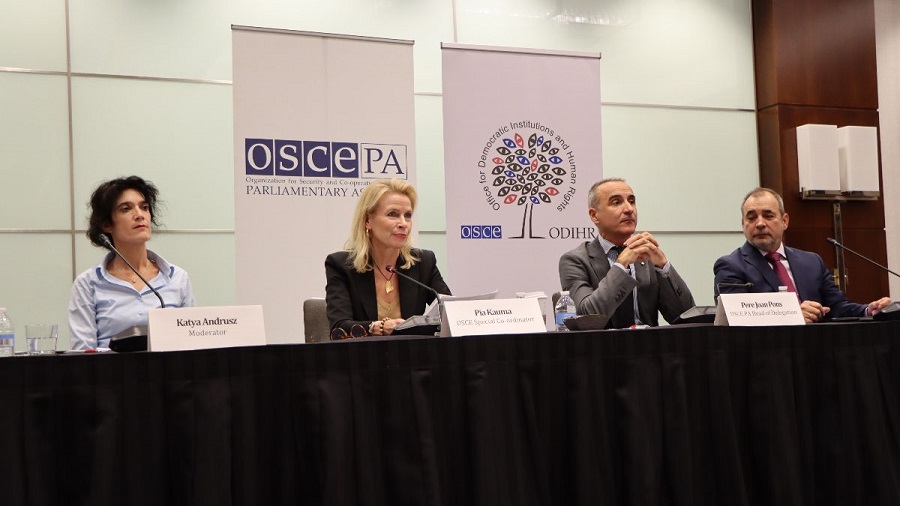WASHINGTON D.C., 6 November 2024 – Engagement was high across the political spectrum in yesterday’s US elections that underscored the resilience of the country’s democratic institutions. The presidential vote was highly competitive, but the campaign was marked by deep polarization and harsh and confrontational rhetoric, while public trust was undermined by disinformation campaigns and political violence, international observers said in a statement today.
The joint observation mission from the OSCE Office for Democratic Institutions and Human Rights (ODIHR) and the OSCE Parliamentary Assembly (OSCE PA) found that while the constitution and a number of federal laws provide a broad and sound framework for holding elections in line with democratic standards, the legal framework has remained mostly unchanged at the federal level since the last elections, leaving most previous ODIHR recommendations unaddressed.
“These elections were a demonstration of the resilience of America’s democratic institutions, as public engagement overcame repeated unfounded claims of elections fraud and divisive rhetoric,” said Pia Kauma, Special Co-ordinator and leader of the OSCE short-term observers. “Especially in this contentious campaign environment, our observations serve to provide a full picture of the situation.”
The elections were organized efficiently and professionally, but threats, harassment, and violence against election administrators were a cause for serious concern and made recruiting election workers a challenge, as well as making additional security measures necessary. Voting technologies were used extensively for voter registration, ballot casting, and vote counting. While a range of useful tools and training were developed to strengthen election safety, concerns about security and assertions from both foreign and domestic sources that sought to sow doubt and delegitimize the electoral process continued to damage public trust.
Read also
An estimated 244 million voters were eligible to vote in these elections. Voter ID remained a controversial issue, with supporters claiming the laws safeguard election integrity and opponents arguing they disproportionately affect various minority groups. Certain segments of the U.S. population remain disenfranchised, despite prior ODIHR recommendations. Election day itself was managed professionally in the polling stations visited by observers, with technical problems such as ballot-scanning errors or voter ID mismatches dealt with promptly.
“Disinformation, threats and even cases of political violence have put this country through a stress test, but these elections showed that the democratic processes in the US remain in good health,” said OSCE PA Head of Delegation Pere Joan Pons. “With campaign spending at record high levels in what appears to be continuous ‘campaign inflation’, systems that enable independent groups to circumvent campaign finance regulations must be amended to avoid inequalities.”
While campaign finance is regulated by federal laws and court rulings that contain detailed regulations on the funding of candidates, the campaigns for this year’s election were marked by record high spending, increasing concerns over unregulated financial contributions and disproportionate advantage for candidates with extensive funding.
Civil and political rights were respected throughout the campaign, but it unfolded in a highly polarized environment amidst personal attacks and incidents of election violence including assassination attempts on former President Donald Trump, as well as mutual accusations between the top-running candidates. Repeated claims by Mr. Trump of widespread electoral fraud in the 2020 elections, as well as his refusal to pledge to accept the outcome of this election, fuelled doubts about a peaceful post-election transition.
“The nuts and bolts of the American electoral process are strong and stable, despite deep mistrust among the general public,” said Tamás Meszerics, who headed the ODIHR election observation mission. “But the sharp polarisation we are seeing across the country, reinforced by the echo chambers that many people are locked into also through the partisan media, are a worrying trend that could seriously damage democracy in the long term.”
Freedom of expression was respected throughout the campaign, and the extensive media coverage provided voters with a basis to make an informed choice on election day. However, the majority of media outlets tailored their coverage to partisan audiences, amplifying political messaging and contributing to political polarization. While there is strong legal protection for media freedom, observers regrettably noted increasing cases of intimidation and harassment targeting journalists.
A large number of lawsuits were filed against new electoral legislation and implementing regulations. Courts enjoyed trust in adjudicating these appeals, although observers heard a high expectation for widespread post-election litigation and further appeals on cases currently under review. There is a legal prohibition of international election observation in 17 states, against the commitments made by all 57 states of the OSCE. At the same time, it was positive to note that partisan and non-partisan observers were present on election day in great numbers, making the process more transparent.
The international election observation is a joint mission of the OSCE Office for Democratic Institutions and Human Rights (ODIHR) and the OSCE Parliamentary Assembly (OSCE PA). The observation mission totalled 249 observers from 45 countries, made up of 85 ODIHR-deployed experts and long-term observers, and 164 parliamentarians and staff from the OSCE PA.
OSCE Parliamentary Assembly






















































